Deciding how much to charge as a copywriter is one of the greatest dilemmas that newbies face. If you set your prices too low, you might look inexperienced. But if you charge too much, it may be hard to find clients. So what’s the right thing to do?
Your copywriting rates depend on your pricing model, experience, etc. Typically, junior copywriters charge $70-$100/hour, mid-level copywriters charge $100-$130/hour, and seniors charge$150-$250/hour. For those charging per word, the optimal rates range between 10 cents to $1 per word.
In this post, we will discuss various pricing models to help you set your rates. Everyone should be able to make decent money with copywriting, but setting prices can be tricky. Let’s dive in!
Copywriting Fees Based On Project Type
To get a clearer picture of how much you should charge, it is insightful to look into the copywriting fees charged by others.
You should, however, keep in mind that these prices are just estimated to guide you. Below is a summary of copywriting rates depending on the type of project.
| Type Of Project | Copywriting Fee Range |
|---|---|
| Simple blog posts for SEO | $150-$800 per post |
| How-to posts | $500- $1,000 per post |
| Press release | $500-$1,000 for a single press release |
| Ad copy( banner or text) | $250- $1,000 per ad |
| Landing page copy for a single promotion | $950- $3,000 |
| 2-5 page microsite copy to boost sales | $3,000- $7,000 |
| Home page content | $1,500- $3,000 |
Growth lab conducted a survey to determine how much copywriters charge per project. Here are the findings.
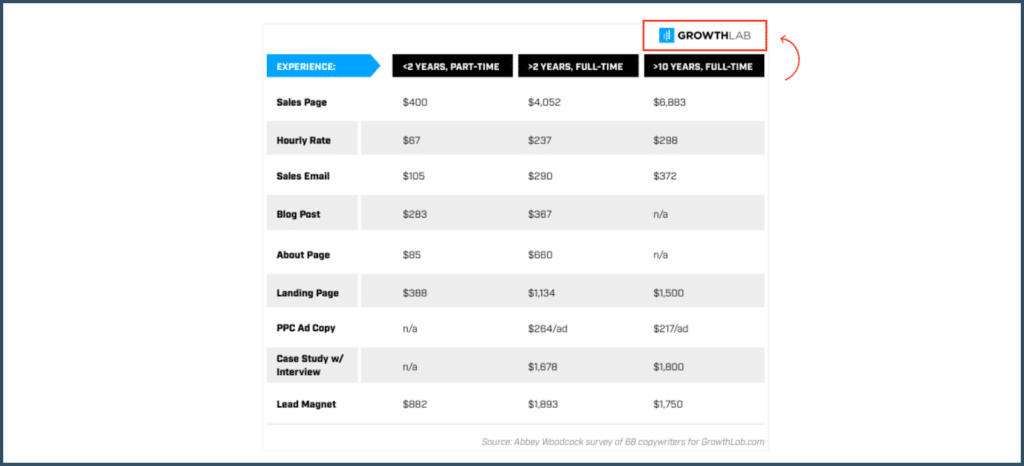
Copywriting Pricing Models
Working as a freelance copywriter gives you the freedom to work on your own terms. But that also means you have to make important business decisions by yourself.
One of the toughest decisions is deciding how much to charge for your work.
There are different models you can follow that will determine how you will be compensated for your work. To help get you started, let’s discuss some of the standard pricing models.
1. Hourly Pricing
This is one of the most common models used by copywriters. In this model, you decide how much you want to earn per hour.
Using this rate, you can calculate an estimated price by multiplying the rate by the number of hours it will take to complete the task. Below are estimates of copywriter hourly rates based on experience:
- Newbie copywriter: $70-$100 per hour
- Intermediate: $100-$130 per hour
- Senior: $150-$250 per hour
As easy as this model seems, it poses a lot of challenges to both the copywriter and the client. You must carefully track your time and present it to your client.
The per-hour format also limits how much you get to earn because it does not consider the value of your copy.
For instance, if you charge $70 for a web page that takes 5 hours to complete, you will earn $350 for the project. The same web page earns the client $10,000.
Looking at this, the hourly rate does not do the copywriter any justice. Another disadvantage is that you risk scaring potential clients if you set a higher rate than others.
Some circumstances may make it necessary to charge by the hour. For instance, when starting out, this is the easiest model to use as you get the hang of things.
The key is to avoid extremely low rates (such as $50 per hour or less). Remember, as a freelancer, you are in charge of a business, including its expenses.
You may also decide to charge per hour if a project is undefined and it is difficult to price it as a whole. Similarly, other projects, such as copy consulting services, are better off when billed by the hour.
2. Per Word Pricing
The per-word pricing is another common pricing model for writing. This applies where a fixed rate is attached to each written word.
For example, if you charge 50 cents per word, you will earn $500 for a 1000-word piece of copy. Depending on their experience, copywriters can earn between 10 cents to $1 per word.
The per-word pricing model is suitable if a client wants regular pieces of copy or if the task requires long-form copy.
On the other hand, pricing per word is not any better than the hourly model as it does not regard your work as a creative service but as a commodity for sale.
Additionally, it focuses on quantity over quality. It is tempting to add fluffy words to the copy just to hit the word count and get paid.
If you’re not careful, the per-word model could result in low-quality copy that reflects poorly on you.
3. Per Project Pricing
Another way to charge for your services is by asking for a predetermined amount for the entire project. This is the best pricing model for many people because it is highly flexible compared to the first two.
Unlike per word and hourly pricing, per project pricing accounts for several factors. Every project is unique, so you must consider the various challenges and details.
The best part is that charging per project enables you to charge for everything that goes into the project, including research, experience, skills, and time.
Reasons You Should Consider Charging Per Project
There are several advantages to pricing per project. First, it emphasizes the value of the words as opposed to their quantity.
For instance, Nike’s tagline “Just Do It” is one of the most memorable taglines ever written, but it’s only three words long. Hopefully, the copywriter wasn’t charged per word!
Another reason to charge per project is that the budget does not dictate the copy length.
Any client serious about getting results knows it is up to the copywriter to use the necessary number of words to make the copy effective.
Also, charging per project helps you to get paid what the copy is worth, regardless of its length. In the per-word model, copywriters can write unnecessary long copy to make money.
But focusing on a project rather than a word count enables you to produce conversion-based copy. Finally, copywriting is more than just writing. You need to research topics, markets, and keywords.
You may even want to conduct interviews, surveys, and other vital processes. Charging per project enables you to get compensation for all the effort you put in.
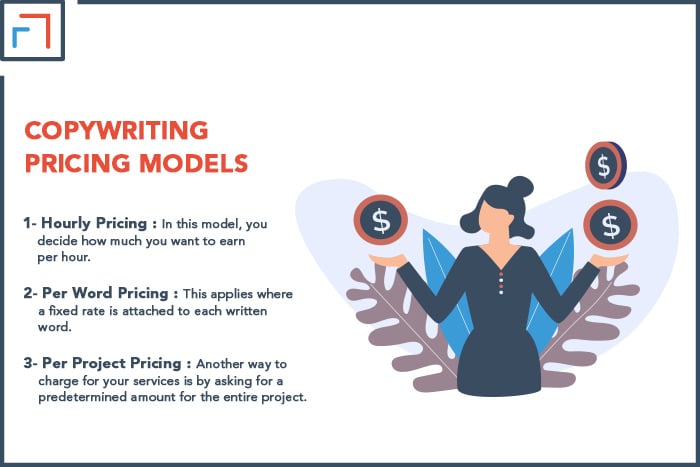
How To Determine Your Rate Per Project
There is no shortcut to determining how much to charge per project because every one is unique. Varied client expectations and project complexity will impact your rates.
Below are some considerations to keep in mind when setting a project price.
1. Project turnaround time: Deadlines are an essential consideration when determining how much to pay.
For instance, tight deadlines mean you have to work twice as hard and prioritize the work over other projects. As such, projects with quicker turnaround times should be more expensive than flexible ones.
2. Specialization: Are you a specialized or general writer? When you specialize, it becomes easier to stand out in your niche and attract clients.
This puts you at an advantage because you can charge more compared to a non-specialized writer.
3. Industry: What is your target industry? Some industries such as tech and finance are more complicated than others and are likely to pay more.
Similarly, if your client is a small business, then you know they work with tight budgets.
You can determine the size of a potential client’s company by looking at their traffic, the number of employees, and their budget.
4. The level of your skills and experience: Copywriters with tons of experience working with high-end clients have no problem charging a premium rate.
However, if you are a beginner, you may have to start a bit low and increase your rates as you grow your skills and experience.
5. Project scope: You must understand what the project entails from the beginning to the end.
This will not only help you to determine the appropriate price, but it will also help you tell when the client asks you to do anything that’s outside the project scope.
If you can handle it, then you’ll be able to charge for the extra work.
6. Project duration: Even if you are not charging by the hour, it is important to consider the project duration. Consider the time you’ll spend on activities like meetings, editing, and revisions.
Projects that take more time should always be more expensive. Your time is valuable!
7. Project type: Finally, you need to consider the type of project you are handling. Each project is unique and has its own requirements. Some projects may be more complex than others, and so on.
For instance, a press release may cost more than a social media post.
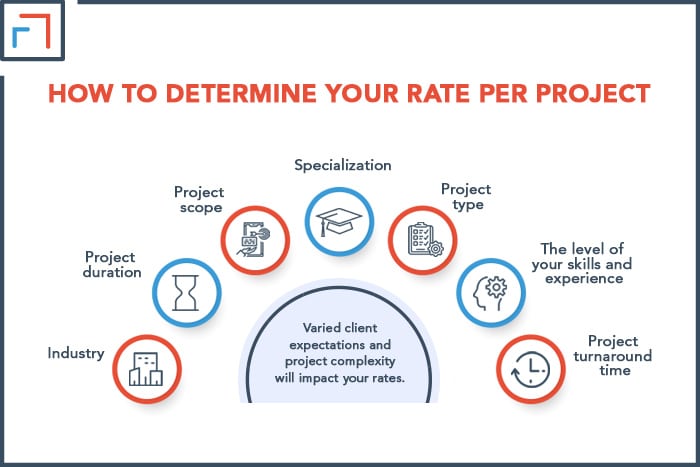
The Service Packaging Model
Clients will go out of their way to pay for any service that adds value and profitability to their business. Packaging your services is one of the best ways to combine your offers and market yourself.
To package your services, pick two or three related services, combine them, and give them unique branding. Then you can charge accordingly.
For instance, if you are writing a sales page, you could combine that offer with an email campaign and some ad copy.
See how this copywriter has packaged her services and named them “The Launch Copy Package.”
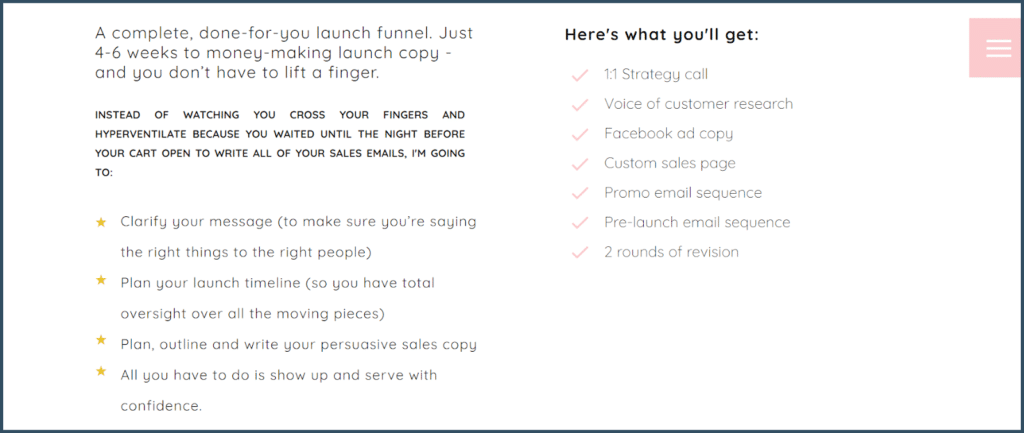
The package above is loaded with value, and a potential client is more likely to take the offer. However, you need to ensure that the package corresponds to the client’s needs so that it may be of use to them.
Tiered Pricing
Although this model is popular in the SaaS (software as a service) industry, it is highly adaptable, and you could use it in your freelance copywriting business too.
It involves segmenting your services to meet clients’ various needs and budgets. The general services are the same, but there are limits across the tiers.
For instance, you can create three tiers, with the first one offering the basics, the second one covering a broad scope, and the third one consisting of all the services. The pricing will also move from low to high.
More clients are likely to choose the middle tier since it meets the widest variety of needs and budgets. So you may want to polish that level to be the most enticing.
The good thing about the tiered pricing model is that it gives your clients more options to choose from. They feel less pressured when they can select the best option for their needs.
This format also prevents clients from asking for additional services that are not included in their chosen tier. Here is an example of tiered services.
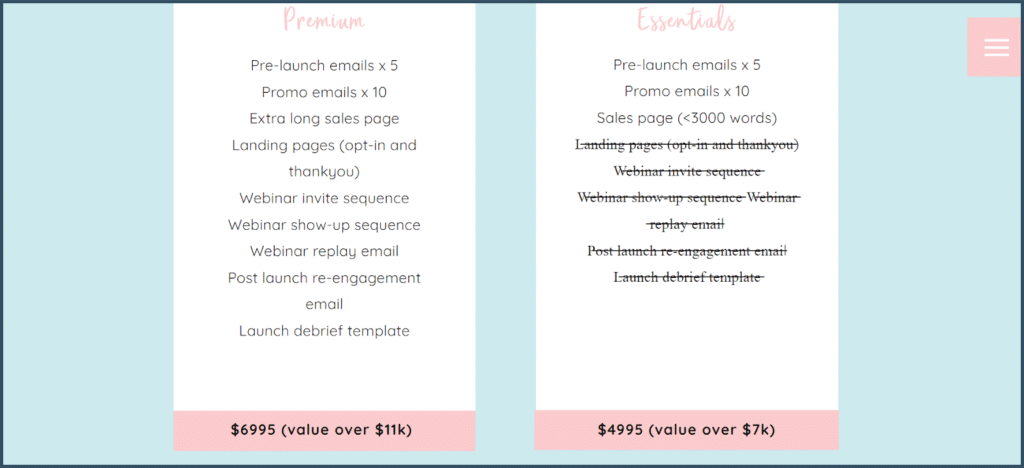
Retainer
Finally, you can use the retainer model to charge for your services. With freelancing, there is no telling when you will get the next gig.
As such, the retainer model is ideal for risk-averse copywriters who want a consistent flow of income.
This model involves a contract agreement between you and the client, specifying that the client will give you recurring tasks every month. For instance, the client may pay you $3,000 for 30 hours of work.
The retainer is a great deal if you have repeat clients. You can easily enter a retainer agreement if you consistently produce high-quality work.
Again, it is best to avoid hourly rates if possible because copywriting doesn’t really work like that. Instead, offer a given number of services for a given price.
For instance, for $1,000 a month, you could create two emails and copy for two ads.
How To Calculate A Suitable Rate For Your Copywriting Services?
From everything you’ve read so far, you should be able to tell that there are no exact figures specifying what you should charge. This is because skills, experiences, and business expenses vary wildly.
Therefore, you just need to find a rate that works for you. The steps below will help you create your ideal rates.
1. Pick A Pricing Model And Determine Your Worth
Since we already discussed the pricing models, we recommend you charge per project. With that in mind, ask yourself what your unique selling point is.
Write down everything you can offer to clients. For instance, your list might look like this:
- 1000-1500 words
- Research
- Interviews
- Statistics
- Editing and revisions
- Driving 500 visitors to a blog every month
2. Factor In Your Expenses And Benefits
Unlike in the corporate world, where the employer covers your insurance, vacations, and office supplies, freelancers have to cover these expenses personally.
When setting your rates, you should factor in these costs. Some items to include are taxes, savings & retirement, business tools and supplies, insurance, and days off.
3. Set Your Rates
While setting an hourly rate isn’t advisable in this line of work, you can use it as a reference to set per-project rates. You can use your monthly income goals to determine your hourly rate.
Divide your target income by the number of days you intend to work. Divide it again by the number of billable hours, and you’ll find your hourly rate.
Use your hourly rate to determine how much you’ll charge per project. You can do this by multiplying the rate by the number of hours it takes to complete the project.
Finally, add 25-30% of this amount to account for your expenses and benefits.

Final Thoughts
The rates for copywriting vary from writer to writer due to differences in location, experience, financial situation, and skills. As such, there is no standard set value for a given piece of copy.
It is best to set your rates based on your skills and goals. First, pick a pricing model that suits your needs and work with it. You can also determine an hourly rate and use it to set project rates.
Most importantly, do not undervalue your services if you are just starting out. Ultimately, it is up to you to set your ideal rates based on what you’ve learned.
